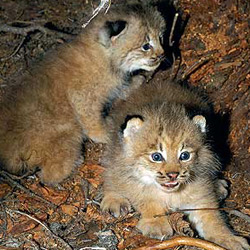Lynx
Updated: August 12, 2020

The lynx and the bobcat are very similar animals, but they are not the same species. There are several marked differences between lynx and bobcats. Lynx are slightly larger. Lynx can grow to over three feet in length and weigh as much as forty pounds. They have longer legs and a lynx's paws are larger to help it run over the snow. Their big, furry feet are used in much the same way people use snowshoes. Their tracks look very large in the snow compared to a bobcat's print.
The winter coat of the lynx is a mixture of shades of silver and gray; a bobcat has more distinct black spotting on its coat. Lynx have black ear tufts, which are thought to help it hear better, and a black tip all around the end of their short tails. Although bobcats also have black at the end of their tails, it is only on the upper half.

Lynx are fast runners and excellent swimmers. They are also very agile climbers, spending some of their time in good weather on the limbs of trees, waiting to ambush a small mammal or bird passing below them. As soon as a hare or grouse ventures close enough, the lynx pounces on the unsuspecting meal.
Snowshoe hares are a lynx's meal of choice. They will also eat small birds, rodents, and deer. They usually take live prey, but occasionally, they will eat the remains of dead beaver, deer, elk, or mouse. Although not a timid hunter, the lynx will rarely fight over its prey if confronted by other carnivores and will leave the kill uneaten. But when it comes to protecting their young, nothing holds them back.
These cats spend most of the day sleeping in a tree, under a ledge or in some other hiding place. Lynx make their dens in hollow logs, caves, beneath roots and other sheltered places. Two kittens are usually born in early summer, and will stay with the mother cat for almost a year, but by the fall, the youngsters will be well on their way to fending for themselves. Siblings often stay together for a time after separating from their mother. A lynx can live to be fifteen to eighteen years old.

Conifer forests are the preferred home of the lynx, but they will also live in areas which have burned out in the past and are growing new trees in areas called secondary growth. Since snowshoe hares like secondary growth, lynx go there to hunt. Most lynx hunt at night and can travel as far as twelve miles on one night to find food.
Populations of lynx increase and decrease along with populations of snowshoe hares, their favorite food. Lynx also are occasionally killed by wolves, mountain lions, bears and humans. A lynx may live in an area the size of ten miles by ten miles, called a home range, for most of his life. Even though their home ranges are relatively small, habitat for lynx is quickly disappearing, as people continue to develop forested regions.
Lynx used to live in most of Northern States and now they only live in Montana, Idaho, Wyoming, Washington, Minnesota and Maine. Today, Montana supports the largest population of lynx in the lower 48 states.
Updated: August 12, 2020

